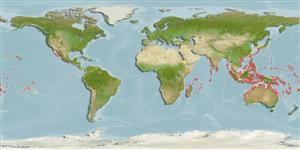>
Gobiiformes (Gobies) >
Gobiidae (Gobies) > Gobiinae
Etymology: Luposicya: Latin, lupus = wolf + Greek, sikya, -as = cucumber (Ref. 45335).
More on author: Smith.
Environment: milieu / climate zone / depth range / distribution range
Ecología
marino asociado a arrecife; rango de profundidad 0 - 15 m (Ref. 48637). Temperate
Distribución
Países | Áreas FAO | Ecosistemas | Ocurrencias, apariciones | Point map | Introducciones | Faunafri
Indo-West Pacific: Pinda, Mozambique to Indonesia, north to Japan. Recently reported from Tonga (Ref. 53797).
Tamaño / Peso / Age
Maturity: Lm ? range ? - ? cm
Max length : 3.5 cm SL macho / no sexado; (Ref. 48637)
Short description
Claves de identificación | Morfología | Morfometría
Espinas dorsales (total) : 7; Radios blandos dorsales (total) : 8; Espinas anales: 1; Radios blandos anales: 8. Characterized by semi-transparent head and body often covered with dense pepper-like spots; presence of thin brown internal stripe interrupted by eight white dash-like marking along dorsal edge of vertebral column; peritoneum silvery or whitish with pair of large brown blotches; snout with a pair of narrow brown stripes; 3-6 lowermost pectoral rays, unbranched and sometimes thickened; longitudinal scale series 26-32; elongated oval or flattened cup shape formed by pelvic fins; restricted gill opening, ranging from just past lower pectoral fin base to below preopercular margin; fleshy snout overhanging lower jaw (Ref. 90102).
Inhabits large sponges, usually on the underside of floppy or fan types that grow on shallow reef flats and down on slopes that are subject to moderate currents (Ref. 48637).
Life cycle and mating behavior
Maturities | Reproducción | Spawnings | Egg(s) | Fecundities | Larva
Benthic spawner.
Goren, M., 1984. Three new species and two new records for the Red Sea of invertebrate associated gobies (Gobiidae, Pisces). Cybium 8(1):71-82. (Ref. 83991)
IUCN Red List Status (Ref. 130435)
Threat to humans
Harmless
Human uses
Herramientas
Special reports
Download XML
Fuentes de Internet
Estimates based on models
Preferred temperature (Ref.
123201): 24.3 - 29.2, mean 28.1 °C (based on 2230 cells).
Phylogenetic diversity index (Ref.
82804): PD
50 = 1.0000 [Uniqueness, from 0.5 = low to 2.0 = high].
Bayesian length-weight: a=0.00708 (0.00333 - 0.01504), b=3.09 (2.92 - 3.26), in cm total length, based on LWR estimates for this (Sub)family-body shape (Ref.
93245).
Nivel trófico (Ref.
69278): 3.2 ±0.3 se; based on size and trophs of closest relatives
Resiliencia (Ref.
120179): Alto, población duplicada en un tiempo mínimo inferior a 15 meses (Preliminary K or Fecundity.).
Fishing Vulnerability (Ref.
59153): Low vulnerability (10 of 100).
Nutrients (Ref.
124155): Calcium = 106 [37, 304] mg/100g; Iron = 0.43 [0.17, 1.03] mg/100g; Protein = 18 [16, 20] %; Omega3 = 0.256 [0.085, 0.714] g/100g; Selenium = 5.25 [1.56, 16.81] μg/100g; VitaminA = 94.6 [15.8, 562.0] μg/100g; Zinc = 1.66 [0.87, 2.98] mg/100g (wet weight);
